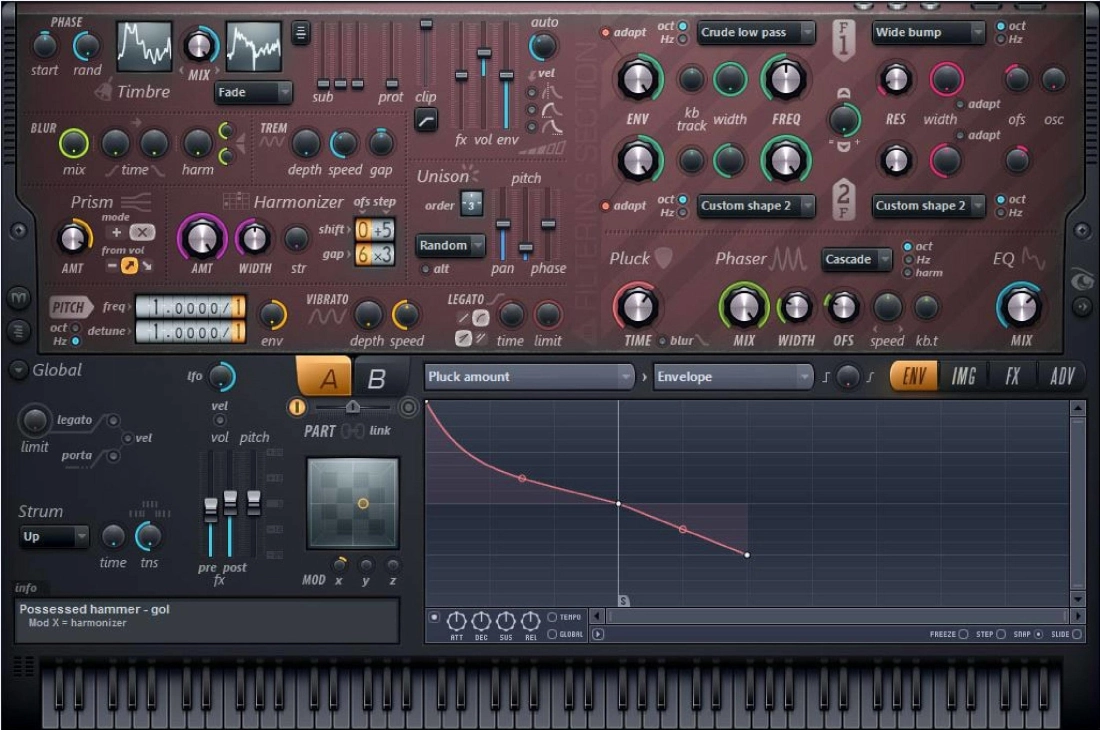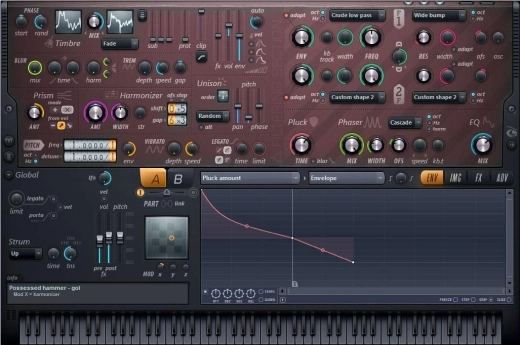Opens in a new window
Image Line Harmor - Download

This product is no longer available.
Powerful additive / subtractive synthesizer, image synthesizer and audio resynthesizer
Harmor is driven by a powerful additive synthesis engine. You don't just select filter types, you draw them. You wanted more, so also featured is the multipoint envelope editor of sytrus fame, applied to over 40 parameters, in 2 independent parts. Through the same envelope/mappings, randomize any parameter or link it to key or velocity, and even fine-tune each unison voice independently.
Processing units can be rearranged in a semi-modular way. If you need one of the 2 filter units processed after the blur unit, that's no problem. Because it typically requires manipulating large amounts (up to 500 per voice) of partials over time, additive synthesis is hard to handle. No human can (or even wants to) edit 500 envelopes, but editing 2d images, that can be done easily. Get access to gain and pitch planes which you can tweak in the image editor of your choice, and import any bitmap, even if it wasn't designed to be turned into audio, it might still sound interesting.
Being an additive synthesizer, Harmor can resynthesize audio files as well. The reproduction will be faithful, not a vague sound-alike as in many additive synthesizers. Resynthesis can of course be tweaked, providing time stretching, pitch shifting, or less conventional manipulations of partials.
Key Features:
• CPU efficency is comparable to that of subtractive synthesizers
• Offers more freedom over oscillators, filters and phasers
• Draw your filter types
• Fine-tune each unison voice independently
• Editing can be done in 2D images
System requirements:
• 2Ghz AMD or Intel Pentium 3 compatible CPU with full SSE1 support
• 512Mb RAM.
• 30Mb free disc space.
• DirectSound or ASIO compatible soundcard.
Harmor is driven by a powerful additive synthesis engine. You don't just select filter types, you draw them. You wanted more, so also featured is the multipoint envelope editor of sytrus fame, applied to over 40 parameters, in 2 independent parts. Through the same envelope/mappings, randomize any parameter or link it to key or velocity, and even fine-tune each unison voice independently.
Processing units can be rearranged in a semi-modular way. If you need one of the 2 filter units processed after the blur unit, that's no problem. Because it typically requires manipulating large amounts (up to 500 per voice) of partials over time, additive synthesis is hard to handle. No human can (or even wants to) edit 500 envelopes, but editing 2d images, that can be done easily. Get access to gain and pitch planes which you can tweak in the image editor of your choice, and import any bitmap, even if it wasn't designed to be turned into audio, it might still sound interesting.
Being an additive synthesizer, Harmor can resynthesize audio files as well. The reproduction will be faithful, not a vague sound-alike as in many additive synthesizers. Resynthesis can of course be tweaked, providing time stretching, pitch shifting, or less conventional manipulations of partials.
Key Features:
• CPU efficency is comparable to that of subtractive synthesizers
• Offers more freedom over oscillators, filters and phasers
• Draw your filter types
• Fine-tune each unison voice independently
• Editing can be done in 2D images
System requirements:
• 2Ghz AMD or Intel Pentium 3 compatible CPU with full SSE1 support
• 512Mb RAM.
• 30Mb free disc space.
• DirectSound or ASIO compatible soundcard.
Q & A
There are currently no questions for this product.
Reviews
There are currently no reviews for this product. Be the first to write one!



